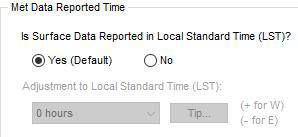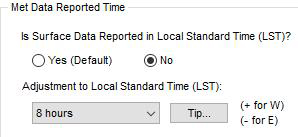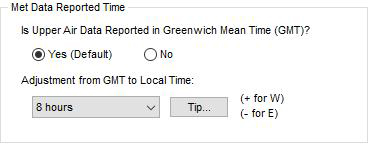Lakes Environmental Newsletter
In this issue:
- News & Events
- Upcoming Courses
- Modeling Tip: AERMET Time Zone Adjustment Factors
- Articles
- Upcoming Conferences & Trade Shows
News & Events
Meteorological Data Services Webinar Held Nov 8, 2017
|
A special thank you goes out to all those who registered and logged in to the 30-minute webinar presentation describing Lakes Environmental, our software solutions and comprehensive global met data services on November 8, 2017. We hope that you found the webinar helpful and that the information provided will enable you to make the most knowledgeable decisions possible for your future environmental air quality project needs. Stay tuned to our monthly newsletter and your inbox for other upcoming webinar dates presented by our highly qualified staff! |
AERMOD and CALPUFF Courses in Dallas, Texas – Feb 5-9, 2018
Lakes Environmental kicks off the 2018 training schedule with a full week of AERMOD and CALPUFF training in Dallas, Texas from February 5 to 9, 2018.
|
CALPUFF course students will have the opportunity to complete a Do It Yourself Case Study using WRF processed data for a location of their choice making this course of great benefit to their modeling work. Early Registration Discount Ends: January 5, 2018 Course: AERMOD (Feb 5-6, 2018) |
AERMOD and CALPUFF Courses in Toronto – Feb 26 – Mar 1, 2018
Lakes Environmental will be in Toronto to present four days of AERMOD and CALPUFF training from February 26 – March 1, 2018.
|
The AERMOD portion of this course will feature a special section and case study regarding the dispersion modeling requirements of Ontario Regulation 419/05: Air Pollution - Local Air Quality. Register online today to take advantage of our early registration discount! Course: AERMOD (Feb 26-27, 2018) |
Lakes Environmental Announces 2018 Training Courses
Lakes Environmental is pleased to announce their 2018 Global Air Dispersion Modeling Training Course Schedule.
|
Course dates and locations for the first half of the year are listed below and can also be found by visiting our website. Join us for training with our world class team of senior level air quality experts!
|
Online registration is already open for some courses! Start making plans now to attend. Early registration discounts will be available for a limited time only!
Lakes Environmental December Holiday Schedule
Please find below the holiday schedule for Lakes Environmental’s offices:
December 18-22 |
Open |
December 25 |
Closed |
December 26 |
Closed |
December 27-29 |
Open |
January 1 |
Closed |
If you have an urgent matter requiring assistance during the holidays, please e-mail us at support@webLakes.com.
Upcoming Courses
Date |
Course |
Location |
Registration |
Nov 27-30, 2017 |
Registration Closed |
||
Feb 5-6, 2018 |
|||
Feb 26-27, 2018 |
|||
Mar 12-13, 2018 |
Gauteng, South Africa* |
Registration |
|
Apr 24-27, 2018 |
Cancun, Mexico |
Registration |
|
May 14-15, 2018 |
AERMOD |
Sydney, Australia** |
Registration |
*Sponsored by NACA
**Sponsored by CASANZ
For more information on the above courses, including registration information, location, and course outlines, please visit our web site: https://www.weblakes.com/courses.html.
Modeling Tip
AERMET Time Zone Adjustment Factors
The correct use of the time zone adjustment factor (parameter tadjust) required by the US EPA AERMET meteorological preprocessor often causes some confusion. The incorrect use of this parameter may lead to a failed AERMET run or incorrect output.
The Time Zone Adjustment Factor (tadjust) is an adjustment factor that is subtracted from the reported hour to convert the time to local standard time. The parameter tadjust should be specified in the AERMET Input File for the following:
|
HOURLY SURFACE DATA
The hourly surface data in AERMET requires the following adjustment:

Several of the data file formats accepted by AERMET are recorded in local time – i.e., the same time zone which the meteorological station is located. This means that the adjustment to local time for surface data will be zero.
The exception is the TD-3505 / ISHD format which is recorded in GMT. For stations using this format, the modeler must supply the number of time zones west (positive number) or east (negative number) of GMT.

AERMET View Surface Pathway Time Zone Setting – Data Recorded in LST

AERMET View Surface Pathway Time Zone Setting – Data recorded in GMT
The Time Zone Adjustment Factor is input to the AERMET Stage 1 input file, under the Surface LOCATION keyword, following the Latitude and Longitude parameters as follows:
LOCATION 24157 47.633N 117.533W 0
UPPER AIR DATA
The upper air data in AERMET requires the following adjustment:

Typically, upper air data is recorded in GMT (Greenwich Mean Time), which means that in most cases the adjustment to local time will be a non-zero value.

AERMET View Upper Air Pathway Time Zone Setting
The Time Zone Adjustment Factor (tadjust) is entered in the AERMET Stage 1 input file, under the Upper Air LOCATION keyword, following the Latitude and Longitude parameters as follows:
LOCATION 00024157 47.633N 117.533W 8
Note that the above example is for a station located in the Pacific Time Zone (GMT -8). For stations west of Greenwich, a positive number should be specified (e.g., for GMT -8 the adjustment is 8). For stations east of Greenwich, a negative number should be specified (e.g., . for GMT +8 Beijing, the adjustment is -8).
ONSITE DATA / APPLICATION SITE
When supplying an onsite data file to AERMET, location information is also provided. This includes a Time Zone Adjustment Factor:

The Time Zone Adjustment Factor (tadjust) is entered in the AERMET Stage 1 input file, under the Onsite LOCATION keyword, following the Latitude and Longitude parameters as follows:
LOCATION SiteID 47.633N 117.533W 0
In addition, for cases where mixing height data are input via the Onsite Pathway in place of using Upper Air data, this LOCATION card is also written to the AERMET Stage 3 input file.
Submit Your Modeling Tips Today!
We are currently accepting submissions for the Monthly Modeling Tip section that appears in our newsletters. If you have a modeling tip that may benefit our readers, please send it to us at support@webLakes.com. Your name and the name of your organization will appear below the tip providing you with an opportunity for increased exposure.
Articles
Exxon to Pay $300 Million to Resolve U.S. Pollution Cases
October 31, 2017 - Exxon Mobil Corp. agreed to pay more than $300 million to resolve air pollution violations tied to eight chemical plants in Texas and Louisiana, one of a pair of environmental settlements with oil companies announced by the Trump administration on Tuesday.
Separately, Denver-based PDC Energy Inc. agreed to pay $22.2 million after storage tanks were found to be leaking smog-forming compounds.
The cases are among the most notable environmental enforcement actions by the Trump administration, with at least one target that hits close to home. Secretary of State Rex Tillerson was chief executive officer at Exxon until late last year.
Utah Air Quality Board to Give Oil, Gas Regulations a Facelift
October 21, 2017 - SALT LAKE CITY - The Utah Air Quality Board is proposing to revamp the way it regulates the oil and gas industry by streamlining the permitting process of producing wells, which make up more than half of the "minor" source permits in the state.
Utah has 12,300 producing crude oil and natural gas wells, according to 2013 numbers, and ranks 10th in the country for natural gas production and 11th for crude oil production.
The majority of those wells are in eastern Utah's Uinta Basin, which struggles with heavy buildup of ozone air pollution in the winter. Ozone is a public health hazard, causing respiratory issues, eye irritation and chest pain.
Little Growth Observed in India's Methane Emissions
October 10, 2017 - Methane is the second most powerful greenhouse gas and concentrations are rising in the atmosphere. Because of its potency and quick decay in the atmosphere, countries have recognised that reduction of methane emissions are a means toward mitigating global warming.
In light of the new international climate agreement, the Paris Agreement, there is increasing need for countries to accurately quantify their greenhouse gas emissions and to have independent checks on this reporting.
In one of the biggest independent studies of its kind, scientists from the University of Bristol have concluded that there has been little growth in India’s methane emissions over the last few years and that reporting of these emissions by the country’s authorities is accurate.
Indonesian City Lands Environmental Award Thanks, in Part, to Use of Nuclear Technique
October 10, 2017 - Bandung, Indonesia – Indonesia’s third largest city has just won the title of ASEAN Environmentally Sustainable City. The use of nuclear techniques to monitor air pollution have contributed to the achievement, city officials have said.
The award is an annual prize that was handed out for the fourth time last month by officials from across the Association of Southeast Asian Nations (ASEAN).
The nuclear technique, which uses particle-induced x-ray emission and X-ray fluorescence technology (See Particle-induced X-ray emission and X-ray fluorescence), was introduced by researchers at the country’s National Nuclear Energy Agency (BATAN), and has been used since the late 1990s to measure particulate matter in the city’s air on a regular basis. The results, for particulate matter with diameter below 10 µm (PM10) and below 2.5 µm (PM2.5), have contributed to a change in city bylaws regulating the burning of agricultural and household waste, as well as the introduction of education programmes to citizens about the harmful effects of burning their waste, said Irene Irmamuti, Head of the Environmental Rehabilitation Section at the city.
Pre-Notification of Updates to Ontario’s Air Dispersion Models
October 3, 2017 - Ontario will be adopting new air dispersion models that are based on latest available science, to provide clarity and consistency to the regulated community and stakeholders.
Ontario’s local air quality regulation (O. Reg. 419/05: Air Pollution – Local Air Quality) under the Environmental Protection Act is part of the province’s air management framework. It regulates air contaminants released into communities by various sources, including local industrial and commercial facilities.
For additional environmental news, visit the Environmental News Network (ENN), the most dependable online environmental news source!

Upcoming Conferences & Trade Shows
Dec 14-16, 2017 |
2017 5th International Conference on Environment Pollution and Prevention (ICEPP 2017) |
Singapore |
Jan 4-6, 2018 |
IAFOR International Conference on Sustainability, Energy & the Environment |
Honolulu, HI, USA |
Jan 7-11, 2018 |
American Meteorological Society (AMS) 98th Annual Meeting |
Austin, TX, USA |
Jan 15-18, 2018 |
World Future Energy Summit |
Abu Dhabi, UAE |
Feb 7-9, 2018 |
2018 9th International Conference on Environmental Science and Development (ICESD 2018) |
Paris, France |
Feb 26 - Mar 2, 2018 |
2nd Pan-GASS Meeting - Understanding and Modelling Atmospheric Processes |
Lorne, VIC, Australia |
Mar 5-7, 2018 |
Energy, Utility & Environment Conference (EUEC) 2018 |
San Diego, CA, USA |
Mar 14-16, 2018 |
GLOBE Leadership Summit for Sustainable Business and Innovation Expo |
Vancouver, CA, Canada |
May 8-10, 2018 |
Canadian Environmental Conference and Tradeshow (CANECT) 2018 |
Vaughan, ON, Canada |
Jun 25-28, 2018 |
111th Air & Waste Management Association's Annual Conference & Exhibition (ACE) |
Hartford, CT, USA |
About this Newsletter
This newsletter contains information gleaned from various sources on the web, with complete links to the sources cited. Organizations cited are in no way affiliated with Lakes Environmental Software.
Lakes Environmental Software is a leading environmental IT company that offers a complete line of air dispersion modeling, risk assessment, emissions inventory, and emergency release software as well as training and custom software services. With satisfied users located around the globe, Lakes Environmental Software will continue to revolutionize the environmental software field.
For more information please visit our web site at: www.webLakes.com. You may also contact us by phone at (519) 746-5995.
All comments and suggestions are welcome. You can e-mail us at: support@webLakes.com.





